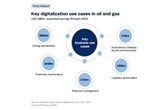Derisking MPD operations
Published by Alfred Hamer,
Editorial Assistant
Oilfield Technology,
Garry Stephen, Vice President, UK and Asia, Oil States, examines the new bar being set in safety and efficiency standards for drilling complex wells.

Managed pressure drilling (MPD) progressed deepwater operations by delivering a critical safety advantage for drilling the world’s most complex and challenging wells. Now a common practice globally, MPD is advancing novel methods and technologies that will push drilling beyond the conventionally un-drillable — and into the next frontier of subsea exploration.
With safety and efficiency driving performance, drillers can standardise their MPD operations by integrating a singular system onboard their offshore assets to minimise risk. Integrating a riser joint into MPD operations provides a streamlined approach to help drilling contractors simplify processes while easing rig-to-rig transfer of technology and crew expertise.
Operational complexity
MPD is an adaptive and advanced drilling solution that has made historically challenging wells feasible. By accurately controlling the annular hydraulic pressure profile throughout the wellbore, MPD provides the dynamic control necessary to drill into difficult reservoirs safely and efficiently, resulting in less nonproductive time (NPT).
MPD is not a singular, standardised process, however. It requires multiple tools and techniques to control pressure while drilling complex formations. Drillers can take a variety of approaches in this closed system to control back pressure and circulating friction, adjust mud density as well as the annular fluid level, and modify fluid rheology among other activities.
In some deepwater pressure reservoirs, such as those found offshore near Brazil, MPD has become a requirement to ensure wellbore pressure is overbalanced and under control. If pressurised mud circulation is too heavy, the formation can crack, or if it’s too light, other issues can occur. Consequently, MPD traditionally adds additional layers of operational complexity with regard to equipment, processes and workflows.
To resolve these application challenges, the Oil States MPD Integrated Riser Joint (IRJ) system enables efficient wellbore pressure control and flow management while also improving the safe handling of gas influx. This combination can significantly reduce the NPT typically encountered with deepwater MPD operations, simplifying deployment and increasing safety.
Increasing safety and efficiency
Unlike legacy equipment, the Oil States IRJ is specifically designed to enhance MPD operational efficiency on-site. With twin retrievable annular seals, the system can remain in place for easy change out between conventional drilling and MPD, simplifying operations through instrumentation integration and NPT. Supplied with the appropriate riser connection and auxiliary line configuration, it seamlessly integrates with a vessel’s existing riser system as it’s compatible with multiple risers and topside equipment from various MPD suppliers. As an advanced automated technology, the IRJ system also gives drillers predictive well control when working in MPD mode to help them mitigate drilling hazards.
Reducing operational complexity by seamlessly switching from MPD operations to conventional drilling using an integrated joint system can save a substantial amount of rig time. This is significant with spread rates breeching US$1 million/d and NPT costing over US$800/min. At 40 – 43 ft in length and a tripping weight of 19 000 kg, the IRJ can be deployed in as little as seven hours – up to 29 hours faster than conventional designs – which can save at least US$1.2 million per deployment. From a health, safety and environmental (HSE) perspective, the integrated system mitigates the need for tandem lifts which minimises equipment damage risks and the amount of time drilling rig personnel are working in the red zone.
Rather than repurpose legacy equipment, the riser joint is purpose-built to be a custom solution for more efficient MPD operations. Its design is more compact and lightweight to allow for safer and easier handling with greater functionality compared to conventional MPD systems. Additionally, its unique retrievable stripper sealing system replaces the large spherical strippers used on conventional systems, which require pulling the full integration joint. Retrieving the stripper packers to the surface through the telescopic joint saves time and operational costs.
To access the full version of this article and get a free trial subscription to Oilfield Technology, sign up here!
Read the article online at: https://www.oilfieldtechnology.com/special-reports/26062025/derisking-mpd-operations/
You might also like
Rystad Energy: Key digital initiatives could save oil and gas industry over US$320 billion
Rystad reports on how digital innovation is changing the oilfield services sector.

